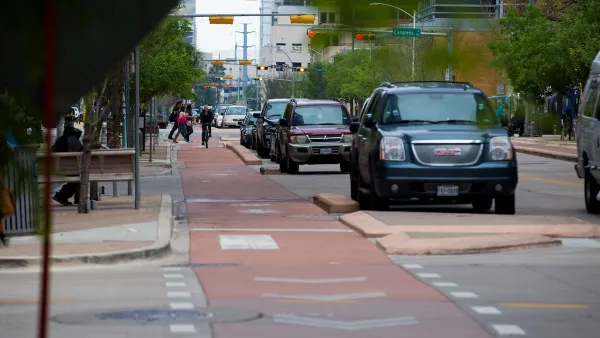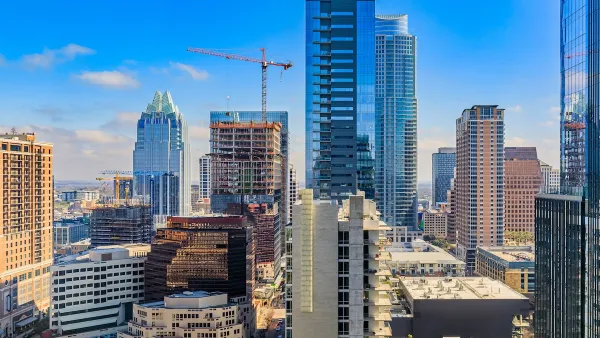Austin is pushing its economic development policy to go beyond chasing the big deal.
According to Andy Borowitz, the city of Austin needs help. “In a deepening humanitarian crisis, residents of the city of Austin report that they are completely surrounded by Texas, a situation that locals are calling ‘dire,’” he wrote in The New Yorker, riffing on Austin’s reputation as a “laid-back” hub for alternative music, film production, and technological innovation in an otherwise conservative state—a reputation that attracts an estimated one hundred new residents daily.
But perhaps the more significant way Austin is currently distinguishing itself from the rest of Texas, and indeed the rest of the country, is its economic development policy.
Chapter 380—A Long Process
Austin is everywhere touted as an attractive place for businesses. It boasts a steadily growing population that is largely college-educated—an estimated 46.7 percent according to 2013 American Community Service data—and, perhaps most enticing to the private sector, it is centrally located in Texas, a state with anti-union laws that does not tax personal income.
But it has seen its share of business cycles. Austin’s current economic development policy can be traced back to 2003, in the wake of the dot-com implosion. Austin had just seen the end of a decade of extraordinary growth. Per capita income had increased from $18,092 in 1990 to $32,039 in 2000, and the average price of a home had skyrocketed from $87,600 in 1990 to $199,500 by 2003. A fast-growing population, the rapid expansion of businesses, and significant investment in technology-related industries and Internet start-ups had helped to bump Austin to the top of the Forbes Magazine-Milken Institute rankings of Best Places for Business and Career in 1999 through 2001.
The national recession after 2001 caused this growth to flatline. Austin’s unemployment rate hit 6.2 percent in January 2003, well above the national average of 5.8 percent. Median family income dropped 5.9 percent from $71,100 in 2002 to $66,900 in 2003.
In addition, the overall income growth of the previous decade belied economic and racial disparities that continued to widen even as the economy began to recover from the recession. With the “tech” economy came high-paying jobs inaccessible to people without a high school diploma or a background in information technology, putting so-called “low-skilled” workers at a distinct disadvantage. While median family income increased slightly for the city’s white and Asian populations between 2000 and 2007, Latino and African-American families saw a sharp drop in median income, from approximately $45,000 a year to just over $37,000. A report released three years later noted that between 2006 and 2010, median earnings in Austin increased by 7 percent for white households but only by 4.9 percent for African-American households; Latino households experienced a 4.3 percent drop in median income during the same period.
At the same time, an influx of residents earning a higher salary drove up the cost of living, making it harder for low-income workers to make ends meet. East Austin, traditionally home to a large African-American community and located close to downtown, was a target for gentrification, which drove up housing prices and pushed out long time African-American residents in a trend that has yet to reverse itself.
FULL STORY: In Austin, Corporations Don't Get Paid for Promises

Analysis: Cybertruck Fatality Rate Far Exceeds That of Ford Pinto
The Tesla Cybertruck was recalled seven times last year.

National Parks Layoffs Will Cause Communities to Lose Billions
Thousands of essential park workers were laid off this week, just before the busy spring break season.

Retro-silient?: America’s First “Eco-burb,” The Woodlands Turns 50
A master-planned community north of Houston offers lessons on green infrastructure and resilient design, but falls short of its founder’s lofty affordability and walkability goals.

Test News Post 1
This is a summary

Analysis: Cybertruck Fatality Rate Far Exceeds That of Ford Pinto
The Tesla Cybertruck was recalled seven times last year.

Test News Headline 46
Test for the image on the front page.
Urban Design for Planners 1: Software Tools
This six-course series explores essential urban design concepts using open source software and equips planners with the tools they need to participate fully in the urban design process.
Planning for Universal Design
Learn the tools for implementing Universal Design in planning regulations.
EMC Planning Group, Inc.
Planetizen
Planetizen
Mpact (formerly Rail~Volution)
Great Falls Development Authority, Inc.
HUDs Office of Policy Development and Research
NYU Wagner Graduate School of Public Service




























